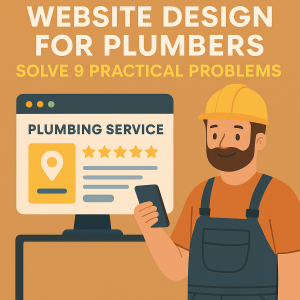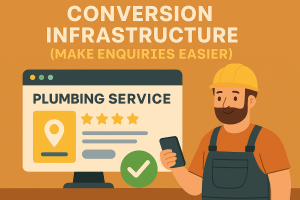Website design for Plumbers: A step by step guide to turning your plumbing website into a lead generating machine

1. Why most plumbing websites in the UK don’t work (and how this guide fixes that)
If you’re like most plumbers in the UK, your “marketing plan” looks something like this:
-
You did your website once (or your mate did it) and haven’t updated it in years.
-
You rely on Checkatrade, Yell, MyBuilder, or word of mouth.
-
You might get the odd enquiry from your site… but you’ve got no idea why or how.
The problem isn’t that plumbing websites “don’t work”.
The problem is that most plumber sites are:
-
Invisible on Google
-
Confusing to customers
-
Not built to collect enquiries
This guide is different.
For each real-world problem plumbers face with their website, you’ll get:
-
A plain-English explanation of what’s going wrong
-
A clear, step-by-step plan to fix it
-
Examples using real UK locations (London, Kent, Manchester, etc.)
If at any point you think, “I’d rather someone just do this for me”, that’s exactly what Construction Web Design UK is built for — but this guide assumes you want to understand and/or DIY as much as possible.
2. Problem #1: “My Website Doesn’t Bring in Any New Leads”
Why This Happens
Most plumbing websites are basically online business cards:
-
A generic home page
-
A phone number somewhere at the top
-
Maybe a list of services in one long block
They don’t guide the visitor to a clear next step. No clear “call us now”, no obvious quote form, and nothing that makes the customer trust you more than the next plumber.
What a High-Converting Plumbing Website Actually Needs
At a minimum, every good plumber website should:
-
Speak directly to specific problems (leaks, boiler breakdowns, blocked drains).
-
Make it incredibly easy to contact you in 1–2 clicks.
-
Show proof that you’re reliable and local.
Step-by-Step: Fixing Lead Generation on Your Website
Step 1 – Create Separate Service Pages
Instead of one “Services” page, create individual pages for:
-
Emergency plumber
-
Boiler repair / boiler installation
-
Bathroom installations
-
Drain unblocking
-
Landlord gas safety checks
-
Heating & radiators
On WordPress, this is:
-
Go to Pages → Add New.
-
Create, for example, “Emergency Plumber in [Your Town]”.
-
Use a clear URL:
-
/emergency-plumber-kent
-
/boiler-repair-manchester
-
On each page, include:
-
H1 title: “Emergency Plumber in Canterbury – 24/7 Call-Out”
-
Opening paragraph: State the problem and promise:
“Burst pipe? No hot water? We provide fast, 24/7 emergency plumbing across Canterbury, Maidstone and surrounding areas.”
-
Bullet list of situations you handle
-
Clear call-to-action: “Call us now on 01234 567890” and/or “Request a call-back” form
Step 2 – Add Strong Calls-to-Action (CTAs)
On every page, you want:
-
A big button: “Request a Quote” or “Call 24/7”
-
Your phone number as a tap-to-call link (on mobiles):
-
In WordPress, link it as tel:01234567890
-
Place CTAs:
-
In the header (top right)
-
In the hero section (“above the fold”)
-
Halfway down the page
-
At the bottom of each page
Step 3 – Add a Simple, Friction-Free Contact Form
Keep it simple. Ask for:
-
Name
-
Phone
-
Postcode
-
Short message
Avoid giant forms with 15 fields — they kill conversions.
In Forminator/Contact Form 7/Elementor:
-
Create a new form.
-
Add just those fields.
-
Place it on your Contact page and repeat it on key service pages.
Step 4 – Make Your Unique Selling Points Obvious
Why should they choose you?
Add a section titled “Why Choose Us” with 3–6 bullet points, e.g.:
-
Gas Safe registered
-
Same-day service available
-
Transparent pricing – no hidden fees
-
Over 100 5★ Google Reviews
These should appear on your Home page and major service pages.
3. Problem #2: “I Don’t Show Up on Google When People Search for a Plumber”
Why This Happens
Google needs clear signals to know:
-
What you do (plumbing, heating, boilers)
-
Where you do it (London, Kent, Manchester, etc.)
If you don’t send those signals, Google will happily show other plumbers instead.
Step-by-Step: Getting Visible in Local Google Searches
Step 1 – Claim and Optimise Your Google Business Profile
-
Go to google.com/business and sign in.
-
Search for your business name; if it exists, claim it. If not, create a new listing.
-
Add:
-
Business name (e.g. “Kent Heating & Plumbing Ltd”)
-
Category: “Plumber” or “Plumbing and Heating”
-
Address (or service area if you’re mobile)
-
Phone number
-
Website URL
-
-
Add at least 10 photos:
-
Your van
-
Before/after jobs
-
Boiler installations
-
Team photos
-
-
Write a description like:
“We’re a Gas Safe registered plumbing and heating company based in Maidstone, serving Kent, Canterbury, Ashford and surrounding areas. We specialise in boiler installations, emergency plumbing and bathroom installations.”
Step 2 – Make Your Website “Local”
On your website:
-
Put your business name, address and phone number (NAP) in the footer.
-
Mention your main towns and cities naturally in your copy:
“We provide boiler repairs across Manchester, Stockport and Salford.”
-
Create a “Areas We Cover” page listing your main areas with a short paragraph on each.
Step 3 – Get Listed in UK Directories (Citations)
Sign up with the same NAP information on:
-
Yell
-
Thomson Local
-
FreeIndex
-
Checkatrade / TrustATrader (if you use them)
-
Google Maps (already done)
These tell Google you’re real and local.
Step 4 – Ask for Reviews Every Week
Reviews are huge for local rankings.
-
After every job, send a simple WhatsApp or text:
“Thanks for choosing us today. Would you mind leaving us a quick Google review? It really helps local customers find us. Here’s the link: [your Google review link].”
Aim for 2–5 reviews per month as a starting point.
4. Problem #3: “My Website Looks Old or Is a Nightmare on Phones”
Why This Matters
Most customers will find you on their mobile phone.
If your site is:
-
Slow
-
Hard to read
-
Needs pinching and zooming
…they’ll hit “Back” and call someone else.
Step-by-Step: Make Your Site Mobile-Friendly and Modern
Step 1 – Test It
Use these tools (free):
-
Google Mobile-Friendly Test – search “Google Mobile Friendly Test”
-
PageSpeed Insights – search “PageSpeed Insights”
Type in your URL and check the mobile score.
Step 2 – Decide: Refresh or Rebuild?
-
If your site is only a couple of years old and built on WordPress → you might just need image compression and layout tweaks.
-
If it’s ancient, on an old builder, or hard to edit → it’s often quicker and cheaper long-term to rebuild on WordPress.
Step 3 – Choose a Good Plumbing Web Design Setup
For plumbers, a robust setup is:
-
Platform: WordPress
-
Theme: a light, modern plumber WordPress theme (from ThemeForest/Envato) or a custom theme from an agency
-
Builder: Elementor or Gutenberg blocks
-
Hosting: a decent UK-based host (SiteGround, Krystal, etc.)
Step 4 – Simplify Your Design
On mobile, less is more:
-
No auto-playing sliders
-
No tiny fonts
-
Keep key items above the fold: phone, CTA, main service promise
A clean hero section might say:
“Local Plumber in Manchester – Same-Day Call-Outs”
[Call Now] [Request a Quote]
5. Problem #4: “People Visit My Website but Don’t Contact Me”
This is a conversion problem — you might be getting some traffic, but the site isn’t convincing them to take action.
Step-by-Step: Turn Visitors into Enquiries
Step 1 – Fix Your Header
Your header (top of every page) should include:
-
Logo on the left
-
Navigation menu
-
On the right:
-
Phone number (clickable on mobile)
-
A button: “Request a Quote” or “Book a Call-Out”
-
Step 2 – Rewrite Your Top Section (Hero)
Your hero area should immediately answer:
-
Who are you?
-
Where do you work?
-
What’s the main benefit?
Example:
H1: “Reliable Plumber in Kent – Fast, Same-Day Repairs”
Subtext: “From leaky taps to full boiler replacements, we help homeowners and landlords across Maidstone, Canterbury and Ashford.”
Buttons: [Call Now] [Get a Fast Quote]
Step 3 – Use Plain, Customer-Focused Language
Instead of:
“We offer a comprehensive range of domestic and commercial plumbing and heating solutions.”
Try:
“We fix leaks, repair boilers, unblock drains and install new bathrooms – with fast response times and clear pricing.”
Talk about outcomes (no more leaks, hot water restored) rather than technical jargon.
Step 4 – Add Social Proof, Not Just Claims
Add a section called “What Our Customers Say” with:
-
3–5 short testimonials (with first name + town)
-
Review star images (Google/Trustpilot/Checkatrade)
-
If possible, screenshots of real reviews
People believe other customers more than your claims.
Step 5 – Reduce Friction in Your Contact Forms
Only ask what you need:
-
Name
-
Phone
-
Postcode
-
Brief description
Every extra field is another reason not to bother.
6. Problem #5: “I Used a Free Template or Builder – Why Isn’t It Working?”
DIY builders promise “a website in minutes”, but they rarely talk about:
-
Ranking on Google
-
Page speed
-
Code quality
-
Conversion rates
Step-by-Step: Moving from a Free/Basic Builder to a Proper Setup
Step 1 – Check Your Current Platform
Ask:
-
Is your site on GoDaddy, Wix, Weebly or one of those drag-and-drop “free” builders?
-
Do you struggle to customise things?
-
Are you locked into their hosting?
If yes, it’s probably time to move to WordPress.
Step 2 – Secure a Good Domain & Hosting
-
If you own your domain (e.g. mycompanyplumbing.co.uk), keep it.
-
Choose a UK host that supports easy WordPress installs.
Install WordPress (many hosts offer “1-click install”).
Step 3 – Pick a Simple, Clean Plumbing Theme
There are many:
-
Search “plumber” or “plumbing” in ThemeForest or Envato Market.
-
Choose one that:
-
Is mobile-responsive
-
Has good reviews
-
Isn’t overloaded with pointless animations
-
Step 4 – Rebuild with SEO in Mind from Day One
As you recreate pages:
-
Use clear URLs:
-
/boiler-installation-kent
-
/bathroom-fitting-london
-
-
Set SEO titles and meta descriptions in Rank Math/Yoast.
-
Add internal links between service pages and your contact page.
If this all sounds like more than you want to take on, this is exactly where Construction Web Design UK comes in — we handle the migration, design and SEO in one go.
7. Problem #6: “I Don’t Have Time to Deal with Websites or Marketing”
You probably didn’t become a plumber to sit behind a laptop obsessing over keywords and page layouts.
Step-by-Step: A Realistic Marketing Routine for a Busy Plumber
If you want to DIY just enough to move the needle:
Weekly (20–30 minutes)
-
Ask 2–3 happy customers for a Google review.
-
Upload 1 photo from a recent job to your Google Business Profile.
-
Share a before/after picture on Facebook or Instagram.
Monthly (1 hour)
-
Check your website contact form still works.
-
Add one new photo or case study to your site.
-
Write a short blog post answering a common question:
-
“Why is my boiler losing pressure?”
-
“How to spot a hidden leak in your house”
-
Option B – Outsource Completely
If that still sounds like too much, you can:
-
Pay an agency (like Construction Web Design UK) to:
-
Monitor your site
-
Update plugins
-
Add content
-
Improve SEO
-
This way you treat your website like your tools: you own them, but a specialist keeps them in top condition.
8. Problem #7: “My Competitors Always Seem to Be One Step Ahead”
Competitors ranking above you on Google aren’t “lucky”. They’re doing specific things.
Step-by-Step: Reverse-Engineer What Your Competitors Are Doing
Step 1 – Identify Your Top 3 Online Competitors
Google:
-
“plumber in [your town]”
-
“boiler repair [your town]”
-
“emergency plumber [your town]”
Write down the top 3 businesses that appear in both the map pack and the normal results.
Step 2 – Study Their Websites
Ask:
-
How many service pages do they have?
-
Do they have blogs?
-
Do they show reviews and logos (e.g. Worcester Bosch Accredited, Gas Safe)?
Notice patterns, this shows you what Google likes.
Step 3 – Check Their Google Reviews
-
How many reviews do they have?
-
Are they recent?
-
Do they reply to them?
Your aim: match and then beat them over time by:
-
Getting more reviews
-
Publishing better content
-
Having a clearer website
Step 4 – Copy the Principles, Not the Wording
Don’t steal content. Instead:
-
If they have a great “Areas We Cover” page, create your own version for your areas.
-
If they have “Emergency plumber” and “Boiler repair” pages, create yours too – but with your own text, photos, and towns.
9. Problem #8: “I Have No Idea What a ‘Good’ Plumber Website Looks Like”
A good site isn’t about being flashy. It’s about:
-
Being clear
-
Being trustworthy
-
Making it easy to contact you
Step-by-Step: Score Your Current Website
Give your site 1–5 for each:
-
Clarity: Can you tell in 5 seconds what you do and where?
-
Trust: Are reviews, accreditations, and photos visible?
-
Ease of Contact: Can you see the phone number and a clear CTA without scrolling?
-
Services: Are your main services obvious and click-through?
-
Speed: Does it feel fast on your phone?
If you’re scoring under 3 on most of those, your site needs work.
Example Layout of a Strong Plumber Website (Homepage)
-
Top bar: Phone + “24/7 Emergency Call-Out”
-
Hero section: H1, subheading, 2 buttons (Call / Request Quote)
-
Service cards: 3–6 major services with icons
-
Why choose us: 3–4 bullet points
-
Testimonials: 3–5 short reviews
-
Gallery or case studies
-
Footer: NAP + service areas + links
10. Problem #9: “I Have No Idea Whether My Marketing Is Working”
If you don’t measure, you’re guessing.
Step-by-Step: Set Up Basic Tracking (Without Being a Tech Nerd)
Step 1 – Install Google Analytics 4
Most hosts or plugins (like Site Kit by Google) let you connect your site in a few clicks.
-
Install “Site Kit by Google” plugin in WordPress.
-
Connect your Google account.
-
Follow the steps to add Analytics and Search Console.
Now you can see:
-
How many people visit your site
-
Which pages are most popular
-
What towns/cities they come from
Step 2 – Monitor Key Metrics Monthly
Once a month, check:
-
How many visitors did I get?
-
Which pages got the most visits?
-
Did enquiries go up or down?
This doesn’t need to be complicated — just note it in a notebook or simple spreadsheet.
Step 3 – Watch the Right Signals
Good signs:
-
More visitors from your target towns
-
More contact form submissions
-
More calls (you’ll notice it in your day-to-day)
Bad signs:
-
High bounce rate (people leave quickly)
-
Very few pages visited per session
If you see bad signs, go back to:
-
Is the page clear?
-
Is there a strong CTA?
-
Is it optimised for a real customer question?
11. Recommended Platforms and Tools (With Simple Explanations)
Here’s a quick breakdown of useful tools and what they are in plain English:
-
WordPress – The engine that runs your website.
-
Elementor / Gutenberg – The tools you use to lay out your pages visually.
-
RankMath / Yoast SEO – Helps you set your page titles, descriptions and other SEO basics.
-
ThemeForest / Envato Market / TemplateMonster – Websites where you can buy pre-designed plumber themes.
-
Google Business Profile – Your free listing on Google Maps.
-
Google Analytics & Search Console – How you see what’s happening on your website.
12. How Construction Web Design UK Can Do All of This For You
If you’ve read this far, you now know:
-
Why your current plumber website isn’t delivering new work
-
Exactly what needs to be fixed
-
Roughly how to do it yourself
But if you’re too busy actually doing plumbing to do all this, that’s where we come in.
Construction Web Design UK specialises in:
-
Plumber web design – modern, mobile-friendly, built to convert
-
Local SEO for plumbers – helping you rank for “plumber in [Town]”
-
Ongoing management – content updates, security, backups, speed, tracking
We can:
-
Audit your current website.
-
Plan a new structure with proper service pages.
-
Design and build it on WordPress with SEO baked in.
-
Take care of it monthly so you don’t have to.
👉 Ready to turn your plumbing website into a proper lead machine?
Book a free website and SEO review today.
13. Quick FAQs for UK Plumbers About Websites & SEO
Q1. Does my plumbing company really need a website if I’m on Checkatrade and MyBuilder?
Yes. Those platforms are great for leads, but you don’t control them. A website you own is your long-term asset and helps you rank directly on Google, build your brand, and not be 100% dependent on third-parties.
Q2. How long will it take to see results from fixing my website?
Basic improvements (like clearer CTAs and better layout) can improve enquiries within days or weeks. SEO improvements may take 2–3 months to show up in rankings.
Q3. Can I just use a free plumbing website template?
You can — but it will look like many others, often be slower, and not be tailored to your local market. A custom or professionally configured site almost always outperforms a generic template.
Q4. What’s the minimum I should spend on a proper plumber website?
As a rough guide:
-
DIY but decent: your time + ~£100–£300 for hosting and a premium theme.
-
Done-for-you: usually from £500–£2,000 depending on complexity and SEO.
Monthly management packages like ours spread that cost and keep everything maintained.
Q5. Do I need ongoing SEO?
If you’re in a competitive city like London, Manchester, Birmingham, then yes – your competitors will be investing, and you’ll need to keep up. In smaller towns, you may get away with a simpler, one-off setup plus occasional updates.
14. Final Word
Your website can either be:
-
A dusty online business card no one sees, or
-
A 24/7 salesperson that brings in consistent plumbing enquiries
The difference isn’t luck. It’s structure, clarity, and a bit of smart SEO.
Whether you follow this guide step-by-step yourself or let Construction Web Design UK do it for you, you now know exactly what needs to change.
💧 Next action:
Open your website on your phone, use the checklists above, and make a list of 3 things you’ll fix this week.
If you’d like help prioritising, grab a free review at






